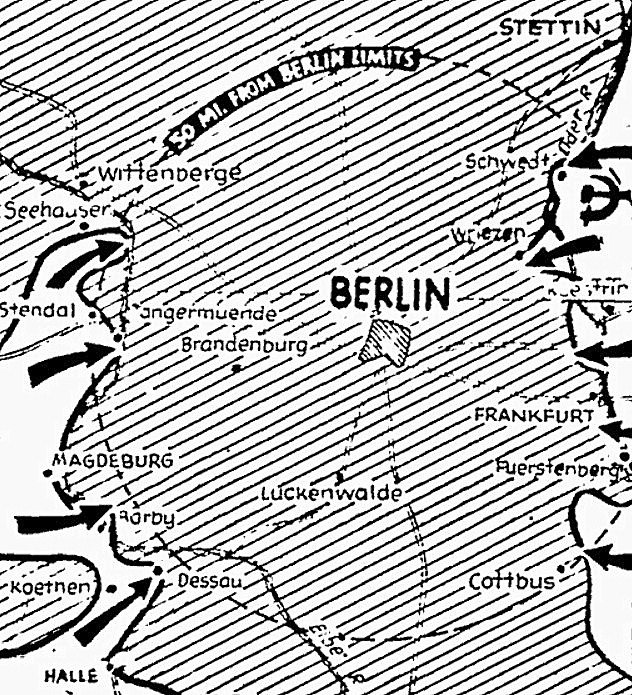The Pittsburgh Press (April 17, 1945)
REDS 17 MILES FROM BERLIN
Heavy fighting rages east of Reich capital
Russians also gain south of city
The race to Berlin
The nearest distances to Berlin from advanced Allied lines today:
EASTERN FRONT: Germans say 17 miles (from northeast of Eberswalde)
WESTERN FRONT: 45 miles (from Elbe River)
ITALIAN FRONT: 516 miles (from near Comacchio)
LONDON, England (UP) – Nazi military sources said today that a big Russian offensive gained up to five miles on the Berlin front yesterday and violent fighting now raged at Eberswalde, 17 miles northeast of the imperiled capital.
Seventy-five miles southeast of Berlin another Soviet onslaught crashed through the Neisse River defense line for gains of 2½ miles in the Muskau-Forst sector, 43 miles northeast of Dresden, on which the U.S. Third Army was driving.
North of Berlin, the Nazis indicated, Soviet assault forces stormed across the Oder below Stettin and near Zehden in the river elbow.
Battle grows
A German military spokesman said the battle in the Oder area as gaining momentum hourly. Other Nazi reports made it plain that the whole Eastern Front was blazing in a general offensive chopping into the hour-glass waist of unoccupied Germany.
The spokesman said the heaviest fighting on the Berlin front was going on in the area of Wriezen, 23 miles northeast of the city and 14 miles southeast of Eberswalde.
On the Neisse front, the spokesman said, the Russians wedged 23 miles into the German positions around Muskau, 15 miles south of Forst. They were reported moving toward Spremberg, 13 miles south of the Cottbus turntable of the southeastern defenses of Berlin and 185 miles northeast of Leipzig.
Linkup reported
While armored forces fought near Eberswalde, two more tank-supported Soviet divisions plunged through the Nazi line east of Letschin, 26 miles to the southeast and 30 miles from the capital, the Germans said.
Only 80-odd miles beyond the Russians near Forst were U.S. Third Army columns.
A Paris report said the Red Army had already linked up with the Americans in the Elbe Valley southeast of Dresden, but latest official dispatches placed the Russians nearly 50 miles and the Americans 40 miles from the purported junction point.
The German Transocean Agency said the Russians were attacking with at least six armies in the Oder triangle directly in front of Berlin bounded by Frankfurt, Kuestrin and Zellin, the latter 15 miles northwest of Kuestrin.
Use smokescreen
Advancing under cover of a smokescreen at the northern corner of the triangle, Transocean said, the Russian made several breaches in the Nazi line east of Letschin, 12 miles northwest of Kuestrin, and four miles beyond the Oder.
Transocean added the usual claim that the breaches had been “sealed off.”
Other German broadcasts said the Russians had dropped paratroops even closer to Berlin, but claimed those were wiped out.
*Gain to northwest
The Germans told of still other penetrations of their lines as far north as Schwedt 45 miles northeast of Berlin, despite Adolf Hitler’s order to hold fast and drown the Berlin-bound offensive in a “sea of blood.”
Altogether, nine infantry, five tank and two air armies were participating in the big offensive, Berlin said.
A Stockholm dispatch said Russian parachutists, including German officers who had been captured at Stalingrad, had been dropped in the Berlin area to confuse Nazi defenses. The officers wore their old German uniforms, the dispatch said.
Appeal for surrender
Other officers seized at Stalingrad were appealing through loudspeakers at the front to German soldiers to surrender.
Lt. Gen. Walter Seydlitz, another of the prisoners and a member of the Free German Committee in Russia, appealed over the Moscow radio to the Germans to lay down their arms “to save as many lives as possible.”
The Soviet High Command, as was its custom in the early stages of a major offensive, was silent on the German claims. But Soviet historian Eugene Tarle said in a Moscow radio talk that the attack on Berlin had begun “from the east and west.”
Use amphibious tanks
The Nazis said the Red Army made its deepest penetration on the Berlin front in the Eberswalde area, 13 miles beyond the big bend in the Oder River.
Soviet amphibious tanks rushed across swamps and canals on a nine-mile front as far as Eberswalde and Bad Freienwalde, where they were meeting stiff resistance from German assault guns, the Nazis said.
Eberswalde lies only four miles from the Stettin-Berlin superhighway and 76 miles northeast of U.S. Ninth Army spearheads in the Stendal area.
Capture Seelow Hills
Due east of Berlin, other Soviet forces merged their bridgeheads across the Oder River on a 20-mile front between Klenitz, 32 miles east of Berlin, and Lebus, five miles north of Frankfurt, then drove on to within 27 miles of the capital.
The strategic Seelow Hills, also 27 miles east of Berlin and 11 miles southwest of Kuestrin, likewise fell to the advancing Russians, German broadcasts admitted.
Still another breach was torn in the German line at Fuerstenberg, 14 miles southeast of Frankfurt, the Germans said.
Far to the south, Moscow announced, Marshal Rodion Y. Malinovsky’s Second Ukrainian Army gained up to 10 miles in converging advances on the Czechoslovak arms center of Brno along a 16-mile front.
Horni Bojanovice, 18 miles southeast of Brno and 146 miles southeast of Prague, was among the towns captured yesterday.
